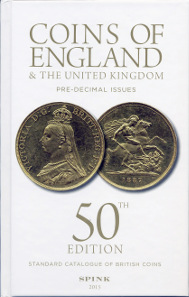by Ursula Kampmann
translated by Annika Backe
February 19, 2015 – The cover of Spink’s “Coins of England & The United Kingdom” 50th edition features the sovereign that was struck in 1887, to celebrate the 50th reigning jubilee of Queen Victoria. Such a sovereign is the prize five readers of the new catalog can win. This is just one example of what the editors have come up with to mark this incredible anniversary.
Standard Catalogue of British Coins, 2 volumes, 50th edition. Spink, London, 2015. Vol. 1: Coins of England & The United Kingdom. Pre-Decimal Issues: 536 p., 14.3 x 22.3 cm, Hardcover. ISBN: 978-1-907427-43-5. / Vol. 2: Coins of England & The United Kingdom. Decimal Issues: 157 p., 13.7 x 21.6 cm, Paperback. ISBN: 978-1-907427-44-2. Both volumes throughout illustrated in colour. Both volumes together: GBP 30.
How many books survive that long, and witness their 50th revised edition? To give you an idea: the German Jaeger, published in 1942 for the first time, is available in its 23rd edition at present. This figure alone indicates quality, for a reference work being a bestseller with collectors for so many years is proof enough that the concept is well-wrought, the facts reliable.
Spink‘s Standard Catalogue of English Coins harks back to the price guides published by coin dealer B. A. Seaby before the War. These lists became quite popular with the collectors who started to use them as reference for their own coins. In 1945, the first official edition of “The Standard Catalogue of British Coins” was released. Back then, it still covered Scotland, Ireland and the Isles as well until the material became so vast that a new catalog was developed, specifically for those areas.
Hence, the current “Coins of England” deals with the coinage of England and the United Kingdom from Antiquity to the Present. The range covers Celtic coins, coinages related to Roman Britain until the Migration Period, Anglo-Saxons and early Norman coinages. The material becomes more overseeable with the Norman Kings after the conquest of 1066. All royal coinages are listed here, in the order of the succeeding kings.
The coin types are arranged according to gold, silver and bronze, from large to small denomination, with prices stated for every coin in different grades. Due to the wealth of material, not every number is illustrated and the comments are short. On the other hand, the Standard Catalogue makes it possible to find a wanted coin at record speed. The illustrations are anything but random! Quite the contrary: Spink has had 70 years to assemble pictures of the best-preserved coins! The photographs surely leave nothing to be desired, in terms of aesthetics and quality.
On the occasion of the 50th edition, the editors treated themselves to a second volume and hence evaded the problem known from the many editions of the Royal Mint’s catalog which became heavier with each year. The Standard Catalogue is divided into before and after the decimal system, with both catalogs being distributed together (yet).
In short, the latest Spink Standard Catalogue is a must-have for everyone dealing with English coins. That this area has gained a great number of new collectors is evidenced by the considerable price increase of British coins that was to be witnessed in the previous months. To all true bibliomaniacs, Spink offers something very special: of the 50th edition there is a collectors’ edition available that features a golden frontispiece, gilt edge and other carefully designed details.
You can order the Standard Catalogue “Coins of England & the United Kingdom” with Spink.






